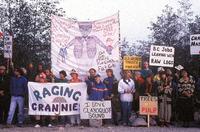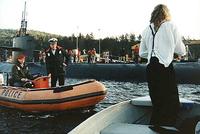Environmental Movement
ENVIRONMENTAL MOVEMENT in BC emerged in its modern form in the 1950s with protests over HYDROELECTRICITY development. The writer Roderick HAIG-BROWN and other conservationists objected to dam building on BUTTLE, CAMPBELL and Upper Campbell lakes on the grounds that valuable wildlife habitat would be lost to rising waters and the pristine wilderness of STRATHCONA PROVINCIAL PARK would be sullied. Although these efforts were largely unsuccessful, future environmentalists took heart from the fact that protestors were able to effect small changes (the dam proposed for Buttle Lk was built on Upper Campbell instead, resulting in less flooding of Strathcona Park) and influence government policy with their actions. From this period onwards, environmental groups objected to numerous hydroelectric projects in BC. In the 1970s they succeeded in halting the expansion of Ross Lk, a reservoir created by US dams, which straddles the BC–Washington border and which would have flooded the SKAGIT R valley. One of their most dramatic successes was the cancellation in 1995 of the so-called Kemano Completion Project, a vast scheme to supply the ALCAN ALUMINUM CO's SMELTER at KITIMAT with additional power; the plan would have reduced the flow of the NECHAKO R, already depleted by the KENNEY DAM.
The preservation of wilderness areas, especially old-growth FORESTS, has provided much of the impetus behind BC's modern environmental movement. Groups such as the Sierra Club of BC and WESTERN CANADA WILDERNESS COMMITTEE have worked tirelessly to protect significant or vulnerable sites in the province. Bitter fights have taken place over MORESBY ISLAND in the QUEEN CHARLOTTE ISLANDS (1974–87), the VALHALLA MTS (1976–83) and the STEIN (1976–88) and CARMANAH (1988–90) valleys, to name just a few. Other wilderness regions, including TATSHENSHINI, KHUTZEYMATEEN and KITLOPE, were the sites of less intense conflicts. FIRST NATIONS groups have played instrumental roles in many of these struggles. Civil disobedience reached a peak in CLAYOQUOT SOUND in 1993, when over 800 anti-logging protestors were arrested and charged.
All the sites mentioned above are now protected or partially protected by parks. Many BC environmental leaders, including David SUZUKI, Colleen McCRORY, Paul George, Joe Foy, Ric CARELESS, Tzeporah Berman, Adriane Carr and Vicky Husband, rose to prominence during these campaigns. In the face of relentless pressure from the public, the BC government developed a Protected Areas Strategy in 1992 with the goal of doubling parkland from 6% to 12% of the province's total area. A crusade by GREENPEACE and the Rainforest Action Network to boycott old-growth timber products from BC had enough success in Europe and the US that in 1995 the BC government adopted the Forest Practices Code, a tough set of regulations on FOREST INDUSTRY practices, and in 1998 MacMILLAN BLOEDEL announced its intention to phase out clearcut logging in old-growth forest areas. In 2001 the provincial government, logging companies and some important environmental groups reached a landmark agreement about logging on the north coast that was hailed by some people as an end to the "war in the woods", at least in that part of the province. The agreement was formalized early in 2006 when the government unveiled a plan for managing the forests of the central and north coast that protected 1.2 million ha of forest as new parks, including a 200,000 ha wildlife zone to protect the KERMODE BEAR. The plan also provided for new types of timber harvesting in the areas left open to logging.
Some of BC's earliest environmental protests concerned nuclear radiation dangers. Greenpeace, now an international organization based in Amsterdam, was founded in VANCOUVER in 1970 to oppose weapons testing in the Aleutian Islands. Led in the 1970s by Bob HUNTER, it became world-famous for its anti-WHALING exploits (see also Paul WATSON, Patrick MOORE) and for protests against the North Atlantic seal harvest. Greenpeace's anti-nuclear activism was echoed in the late 1990s in BC by protests over the possible appearance of nuclear-capable submarines at the NANOOSE BAY naval testing range.
The protection of wildlife and wildlife habitat in BC has gone hand in hand with efforts to preserve wilderness and old-growth forests. Ironically, much of the initial energy behind the environmental movement came from hunting and sport FISHING organizations such as the BC WILDLIFE FEDERATION and Steelhead Society of BC, which sought to enhance recreational opportunities for members. Important habitat restoration projects in the province have been undertaken by these and other groups, including Ducks Unlimited and the FEDERATION OF BC NATURALISTS.
Aquatic habitats are a particular environmental worry in BC, which has 24,000 LAKES, RIVERS and streams and a 27,200-km coastline. Conservationists have prevented the OIL AND GAS INDUSTRY from exploring offshore since 1972. The PULP AND PAPER industry, targeted by the environmental movement for its toxic discharges, spent large amounts in the 1990s to clean up effluents. Acid drainage from current and obsolete BC mines (see MINING) is a related issue; environmental protests have erupted over future developments by Redfern Resources (Tulsequah Chief), Princeton Mining (Huckleberry), Royal Oak (Kemess South) and Manalta Coal (Telkwa). AQUACULTURE is the latest BC industry to come under scrutiny: environmentalists are demanding that salmon farms use tanks or "closed" farming systems instead of open pens and that they be banned from sensitive parts of the coast. The Living Oceans Society has lobbied BC and Canadian governments for a system of marine protected areas similar to those now established on land; other groups seek reductions in sport and commercial FISHING quotas. The destruction of ESTUARIES, especially that of the FRASER R, through urban development is another major concern for environmentalists.
In urban areas the environmental movement has directed its energies toward issues such as air pollution from automobile emissions; traffic congestion; water quality and usage; transportation options, including rapid transit and bicycle lanes; sewage treatment and garbage disposal; the loss of AGRICULTURAL land to development; and spraying to exterminate GYPSY MOTHS.
By the year 2000 hundreds of BC-based environmental organizations were active, with tens of thousands of members. Many groups, such as the Georgia Strait Alliance or the Friends of Clayoquot Sound, focus their energies on a particular area. Others, including the David Suzuki Foundation, West Coast Environmental Law Association, Canadian Earthcare Society, BC ENVIRONMENTAL NETWORK, Land for Nature, SIERRA LEGAL DEFENCE FUND and the Land Conservancy of BC, have a broad outlook. BC's GREEN PARTY reflects the environmental movement's political aspirations. While the party has yet to come close to electing a provincial MLA, it has had success on the municipal level; members were elected to Vancouver's parks board and Victoria's city council for the first time in 1999. See also AGRICULTURAL LAND RESERVE; BIODIVERSITY, COMMISSION ON RESOURCES AND THE ENVIRONMENT; ENDANGERED SPECIES; SOCIETY PROMOTING ENVIRONMENTAL CONSERVATION.
by Andrew Scott


